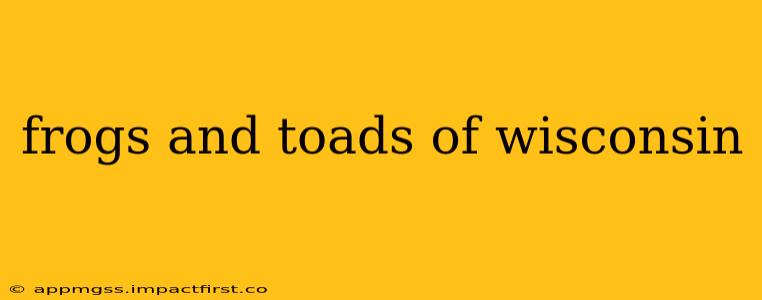Wisconsin, with its diverse habitats ranging from forests and prairies to wetlands and lakes, boasts a fascinating array of amphibian life. Among these, frogs and toads hold a special place, captivating both nature enthusiasts and casual observers alike. This guide explores the various species found in the Badger State, their unique characteristics, and the crucial role they play in the ecosystem.
What are the different types of frogs and toads in Wisconsin?
Wisconsin is home to a variety of frog and toad species, each with its own distinct features and habitats. Some of the most common include:
- American Toad (Anaxyrus americanus): Easily recognized by its warty skin and short legs, the American Toad is widespread across Wisconsin. They prefer terrestrial habitats but need access to water for breeding.
- Fowler's Toad (Anaxyrus fowleri): Similar to the American Toad but with a more pronounced cranial crest and a slightly different call. They tend to inhabit drier areas than their American counterparts.
- Northern Leopard Frog (Lithobates pipiens): A large, agile frog with distinctive dark spots along its back. It's a common sight near ponds, marshes, and slow-moving streams.
- Bullfrog (Lithobates catesbeianus): The largest frog in Wisconsin, the Bullfrog is easily identifiable by its massive size and deep, booming call. They prefer larger bodies of water.
- Green Frog (Lithobates clamitans): A medium-sized frog with a distinctive dorsolateral fold running down its back. They are often found near ponds and streams.
- Gray Treefrog (Hyla versicolor): A small, arboreal frog with mottled gray or green skin. They are excellent climbers and are often found in trees and shrubs near water.
- Spring Peeper (Pseudacris crucifer): A tiny frog with a distinctive "peep" call, especially prevalent in early spring. They inhabit various woodland habitats.
- Chorus Frog (Pseudacris triseriata): Another small frog with a distinctive trilling call, often heard in wetlands and marshes.
How can I identify frogs and toads in Wisconsin?
Identifying frogs and toads requires careful observation of several key features:
- Size and shape: Note the frog or toad's overall size and body proportions. Are the legs long or short? Is the body slender or stout?
- Skin texture: Is the skin smooth, warty, or bumpy? This is a crucial differentiating factor between frogs and toads (toads generally have warty skin).
- Color and markings: Pay close attention to the color and pattern of the skin. Spots, stripes, and other markings can be important identification clues.
- Call: The mating call of frogs and toads can be a very effective identification tool. Use online resources or field guides to learn the different calls of Wisconsin species.
- Habitat: The environment where you observe the amphibian can provide valuable clues about its identity.
Where can I find frogs and toads in Wisconsin?
Wisconsin's diverse habitats provide suitable homes for a variety of frog and toad species. You're most likely to encounter them near:
- Wetlands: Marshes, swamps, and bogs provide breeding grounds and essential habitat for many species.
- Ponds and lakes: Larger bodies of water support larger frog species like Bullfrogs and Green Frogs.
- Streams and rivers: Some species prefer the flowing waters of streams and rivers.
- Forests: Many frogs and toads utilize forested areas for shelter and foraging.
- Prairies: Some species, like the American Toad, can be found in prairie habitats.
What is the best time to look for frogs and toads in Wisconsin?
The best time to observe frogs and toads depends on the species and the season. Spring is generally a good time to hear their calls, especially during breeding season. However, you can spot them throughout the warmer months, particularly after rain. During the day, many species are less active, so early mornings and evenings are often better for observing.
Are frogs and toads poisonous in Wisconsin?
While none of Wisconsin's frog and toad species are deadly poisonous to humans, some can secrete toxins that cause irritation if handled. It’s best to admire them from a distance and avoid handling them unnecessarily to protect both yourself and the amphibians.
What role do frogs and toads play in the Wisconsin ecosystem?
Frogs and toads are integral parts of the Wisconsin ecosystem, playing crucial roles in the food web:
- Pest control: They consume large numbers of insects, helping to regulate insect populations.
- Food source: They serve as prey for larger animals, including birds, snakes, and mammals.
- Indicators of environmental health: Their presence or absence can be an indicator of the overall health of the ecosystem.
By understanding and appreciating the frogs and toads of Wisconsin, we can better appreciate the biodiversity of our state and contribute to their conservation. Remember to observe responsibly and leave these fascinating creatures undisturbed in their natural habitats.
